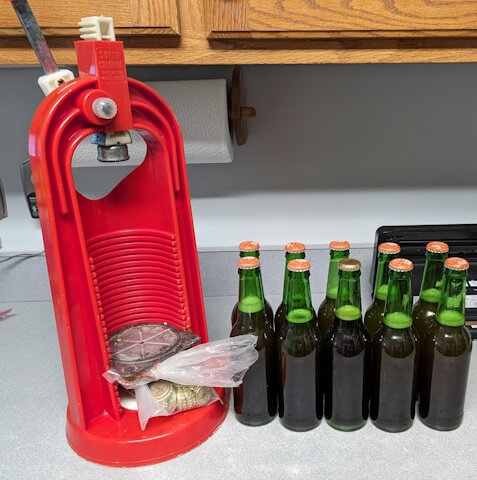Kombucha Batch #24-02
updated 04/20/2024
April 2024
Immediately after bottling batch 24-1, I started this one.
04/20/2024
The last batch was bottled at the 30 day mark. I have one bottle from last year’s final batch, which aged for 90 days. We’ll compare the tartness level.
For this batch I upped the tea to 4 Tbsp tea in 1 liter boiling water, letting it steep for 15 minutes. Another change was my son gave me a stainless steel strainer to replace the el cheapo bag that came with the kit. He ordered one, and when he received it, he discovered he received 2, so he gave me one.
As usual, I stirred 1 cup table sugar into the tea, then added a 4 cup measure of ice cubes to cool it faster. Once it cooled to 75 F, I poured it into the jar and filled with water.
06/09/2024
 I finally got around to bottling this one. I made a few changes to the process, using 1/4 cup Super Food juice from Aldi’s. The 1/3 cup juice I used last time over-powered the tea. It was good, but I’d like to taste the tea.
I finally got around to bottling this one. I made a few changes to the process, using 1/4 cup Super Food juice from Aldi’s. The 1/3 cup juice I used last time over-powered the tea. It was good, but I’d like to taste the tea.
My process is to have a large bowl handing, and using 2 slotted spoons, transfer the SCOBY from the jug to the bowl. I stir the liquid in the jug to homogenize, then add 1 cup to the bowl containing the SCOBY.
I figured I’d get 8 to 9 bottles from this batch, so I lined up 9, adding 1 Tbsp sugar and then 1/4 cup juice to each using a funnel.
I repeatedly filled a 4 cup measure with kombucha, pouring enough into each bottle to fill it to the shoulders. I’m using 12 oz Molson’s beer bottles as it’s easy to see the level in the bottle. My son uses 16 oz swingtop bottles, but since I have a capper and several cases of empties, I decided it wasn’t necessary. Also, I tend to drink the whole bottle, so re-sealing an open bottle isn’t necessary, and I get more bottles overall (same volume of kombucha).
Due to foaming I have to make a second pass on some bottles after the foam subsides.
The last bottle was a bit short, so I added more juice. In the picture, that’s the one in the middle front — if you look carefully it has a different bottle cap.
I’ve owned the capper since 1984 and the Orange Nehi caps are probably 35 years old, leftovers from my LHBS, The Winery which was in Rome NY. I was out of beer making for a while (and currently make only sporadically), so I tested the caps about 15 years ago, and they worked fine. I only have 8 caps of that batch left, so my next kombucha will use ’em up.
The odd bottle cap is an overrun from a Japanese beer, that I purchased about 15 years ago.
A bit of history — when I started making beer (1984), plain caps were available, but overruns of soda caps were about half the price. Same cap, just said Grape Nehi or something on it. When the vendors made too many caps, they’d dump them on the home beer making market. I saw no value in spending extra money on something I was going to toss away in a month or three, so I purchased overruns.
Today? American Brewmaster sells a variety of colors of plain caps. When I run out of caps (which will be a while, I have another bag in the winery), I’ll pick a color
